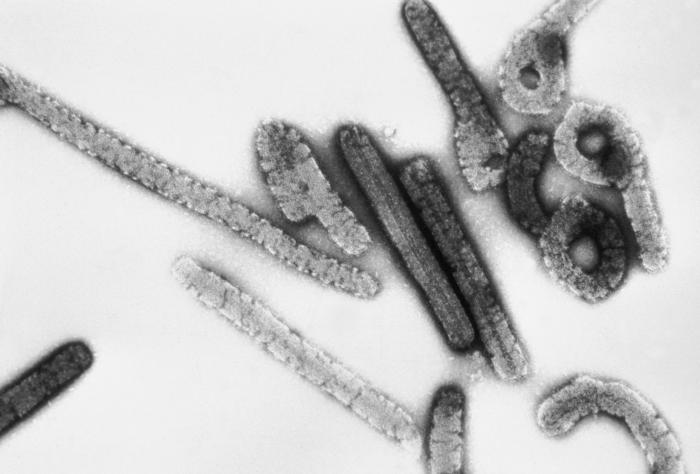Marburg virus disease
Editor-In-Chief: Prab R Tumpati, MD
Obesity, Sleep & Internal medicine
Founder, WikiMD Wellnesspedia &
W8MD medical weight loss NYC and sleep center NYC
| Marburg virus disease | |
|---|---|

| |
| Synonyms | N/A |
| Pronounce | N/A |
| Specialty | N/A |
| Symptoms | Fever, headache, muscle pain, vomiting, diarrhea, rash, bleeding |
| Complications | Severe bleeding, organ failure |
| Onset | 2 to 21 days after exposure |
| Duration | 7 to 21 days |
| Types | N/A |
| Causes | Marburg virus |
| Risks | Exposure to caves or mines, contact with infected animals or humans |
| Diagnosis | PCR, antibody tests |
| Differential diagnosis | Ebola virus disease, malaria, typhoid fever, meningitis |
| Prevention | Avoiding exposure, protective clothing, infection control |
| Treatment | Supportive care, rehydration, blood products |
| Medication | N/A |
| Prognosis | High mortality rate |
| Frequency | Rare |
| Deaths | Varies by outbreak |
Marburg virus disease is a severe and highly fatal disease caused by a virus from the same family as the one that causes Ebola virus disease. Both viruses are native to Africa, where sporadic outbreaks have occurred for decades.
History[edit | edit source]
Marburg virus disease was first recognized in 1967, when outbreaks of hemorrhagic fever occurred simultaneously in laboratories in Marburg and Frankfurt, Germany and in Belgrade, Yugoslavia (now Serbia). A total of 31 people became ill, including laboratory workers as well as several medical personnel and family members who had cared for them. The first people infected had been exposed to African green monkeys or their tissues. In Marburg, the monkeys had been imported for research and to prepare polio vaccine.
Transmission[edit | edit source]
Marburg virus is transmitted to people from fruit bats and spreads among humans through human-to-human transmission. The Marburg virus is transmitted through close contact with the blood, secretions, organs or other bodily fluids of infected animals. In humans, the Marburg and Ebola viruses, both members of the Filoviridae family, have been known to be transmitted through contact with infected bodily fluids.
Symptoms[edit | edit source]
The onset of the disease is sudden, with high fever, severe headache, muscle pain and chills. By the fifth day, a rash can occur. Nausea, vomiting, chest pain, a sore throat, abdominal pain, and diarrhea then may appear. Symptoms become increasingly severe and may include jaundice, inflammation of the pancreas, severe weight loss, delirium, shock, liver failure, and multi-organ dysfunction.
Treatment[edit | edit source]
There is no specific treatment for Marburg virus disease. Patients are given supportive care, which includes balancing the patient’s fluids and electrolytes, maintaining their oxygen status and blood pressure, and treating them for any complicating infections.
Prevention[edit | edit source]
Prevention includes reducing the risk of wildlife-to-human transmission and human-to-human transmission. Health-care workers caring for patients with suspected or confirmed Marburg virus should apply infection prevention and control measures to prevent contact with patients’ blood, fluids, or contaminated surfaces or materials such as clothing and bedding.
Transform your life with W8MD's budget GLP1 injections from $125
W8MD offers a medical weight loss program NYC and a clinic to lose weight in Philadelphia. Our W8MD's physician supervised medical weight loss centers in NYC provides expert medical guidance, and offers telemedicine options for convenience.
Why choose W8MD?
- Comprehensive care with FDA-approved weight loss medications including:
- loss injections in NYC both generic and brand names:
- weight loss medications including Phentermine, Qsymia, Diethylpropion etc.
- Accept most insurances for visits or discounted self pay cost.
- Generic weight loss injections starting from just $125.00 for the starting dose
- In person weight loss NYC and telemedicine medical weight loss options in New York city available
- Budget GLP1 weight loss injections in NYC starting from $125.00 biweekly with insurance!
Book Your Appointment
Start your NYC weight loss journey today at our NYC medical weight loss, and Philadelphia medical weight loss Call (718)946-5500 for NY and 215 676 2334 for PA
Search WikiMD
Ad.Tired of being Overweight? Try W8MD's NYC physician weight loss.
Semaglutide (Ozempic / Wegovy and Tirzepatide (Mounjaro / Zepbound) available. Call 718 946 5500.
Advertise on WikiMD
|
WikiMD's Wellness Encyclopedia |
| Let Food Be Thy Medicine Medicine Thy Food - Hippocrates |
Translate this page: - East Asian
中文,
日本,
한국어,
South Asian
हिन्दी,
தமிழ்,
తెలుగు,
Urdu,
ಕನ್ನಡ,
Southeast Asian
Indonesian,
Vietnamese,
Thai,
မြန်မာဘာသာ,
বাংলা
European
español,
Deutsch,
français,
Greek,
português do Brasil,
polski,
română,
русский,
Nederlands,
norsk,
svenska,
suomi,
Italian
Middle Eastern & African
عربى,
Turkish,
Persian,
Hebrew,
Afrikaans,
isiZulu,
Kiswahili,
Other
Bulgarian,
Hungarian,
Czech,
Swedish,
മലയാളം,
मराठी,
ਪੰਜਾਬੀ,
ગુજરાતી,
Portuguese,
Ukrainian
Medical Disclaimer: WikiMD is not a substitute for professional medical advice. The information on WikiMD is provided as an information resource only, may be incorrect, outdated or misleading, and is not to be used or relied on for any diagnostic or treatment purposes. Please consult your health care provider before making any healthcare decisions or for guidance about a specific medical condition. WikiMD expressly disclaims responsibility, and shall have no liability, for any damages, loss, injury, or liability whatsoever suffered as a result of your reliance on the information contained in this site. By visiting this site you agree to the foregoing terms and conditions, which may from time to time be changed or supplemented by WikiMD. If you do not agree to the foregoing terms and conditions, you should not enter or use this site. See full disclaimer.
Credits:Most images are courtesy of Wikimedia commons, and templates, categories Wikipedia, licensed under CC BY SA or similar.
Contributors: Prab R. Tumpati, MD





